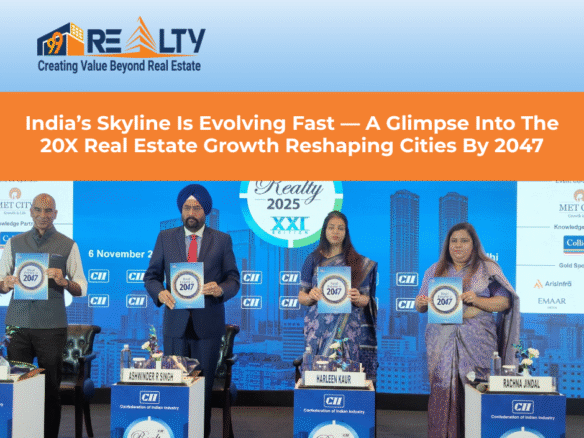India’s real estate market is witnessing a widening gap between luxury and affordable housing segments. While premium housing dominates metro skylines, millions still struggle to find affordable homes. Bridging this divide is crucial for fostering economic balance, ensuring urban development is inclusive, and unlocking untapped potential for real estate investors.
According to Aayush Puri, a prominent PropTech entrepreneur at ANAROCK, India’s real estate sector must evolve to address this disparity effectively. Developers, policymakers, and investors need to align strategies to cater to both segments efficiently.
Understanding the Demand Dynamics in Indian Housing
The Rise of Luxury Housing in Metro Cities
Luxury housing has witnessed remarkable growth in key metropolitan cities like Mumbai, Delhi-NCR, Bengaluru, and Hyderabad. High-net-worth individuals, NRIs, and affluent investors are driving this demand, seeking premium amenities, enhanced security, and prime locations.
Developers have increasingly focused on luxury projects to ensure higher profit margins. As a result, the availability of affordable housing in these regions has steadily declined.
Comprehensive Guide to Long-Term Capital Gains Tax on Property for High-Net-Worth Individuals in India
The Growing Demand for Affordable Housing
Conversely, the demand for budget-friendly housing continues to surge, especially in tier-2 and tier-3 cities. Migrants seeking employment in urban hubs are actively looking for economical yet well-connected living spaces.
Government schemes like Pradhan Mantri Awas Yojana (PMAY) have propelled this segment, yet supply still struggles to meet the overwhelming demand.
Key Challenges in Bridging the Housing Gap
Land Acquisition and Development Costs
Acquiring suitable land for affordable housing in metro areas is a persistent challenge. Escalating land costs and complex zoning laws restrict developers from initiating low-margin budget housing projects.
Regulatory Hurdles and Approval Delays
The Indian real estate sector is plagued with bureaucratic red tape. Lengthy approval processes, inconsistent regulations, and delays in permits often discourage developers from investing in affordable housing initiatives.
Financing Challenges for Developers and Buyers
Affordable housing projects typically generate lower profit margins. Developers struggle to secure funding for such ventures, while low-income buyers face difficulties accessing home loans due to stringent eligibility criteria.
Innovative Solutions to Bridge the Housing Divide
Mixed-Use Developments to Cater to Varied Income Groups
Aayush Puri emphasizes the potential of mixed-use developments, where luxury apartments and budget housing coexist within the same community. This model optimizes land use, balances social demographics, and enhances accessibility to shared amenities.
Government Policies to Promote Inclusive Housing
Policymakers must expand tax incentives, expedite approval processes, and introduce interest subsidies for budget housing developers. Programs like PMAY, RERA, and the Smart Cities Mission are pivotal in promoting affordable housing.
Benefits of the RERA Act for Homebuyers
Private Sector Collaboration for Affordable Living
Public-private partnerships (PPP) offer a robust solution to India’s housing crisis. By working collectively, government bodies and private developers can accelerate construction, reduce costs, and ensure low-income families access quality living conditions.
The Role of Technology in Affordable Housing Solutions
AI-Driven Pricing Strategies
AI-based analytics tools help developers understand demand patterns and predict market trends. By leveraging data insights, developers can price properties strategically, ensuring they cater to budget-conscious buyers without compromising profits.
Virtual Property Tours and Digital Transactions
Virtual property tours, augmented reality (AR) visualization, and online payment portals enhance buyer convenience, reducing marketing costs and improving outreach to potential homeowners.
Top Technology Trends Revolutionizing Real Estate in 2024
Sustainable Building Practices for Cost Efficiency
Energy-Efficient Designs
Eco-friendly architecture, such as solar panels, rainwater harvesting systems, and energy-efficient insulation, reduces operational costs for homeowners, making properties more affordable in the long run.
Eco-Friendly Materials for Cost Reduction
By integrating recycled materials, prefabricated structures, and modular construction methods, developers can minimize expenses without compromising durability.
Sustainable Real Estate Development Paving the Way for a Greener India
Investment Opportunities in the Indian Housing Sector
Emerging Markets for Affordable Housing
Tier-2 and tier-3 cities like Lucknow, Indore, Coimbatore, and Nagpur are emerging as hotspots for affordable housing investments. Lower land costs and improved infrastructure make these cities ideal for developers aiming to expand budget-friendly projects.
The Rising Dominance of Tier 2 and Tier 3 Cities in India’s Real Estate Market
Luxury Housing as a Lucrative Growth Avenue
Despite the pressing need for affordable housing, luxury real estate remains a profitable avenue. As urbanization continues to expand, the demand for premium homes in strategic locations is expected to rise.
Expert Insights from Aayush Puri, PropTech Entrepreneur at ANAROCK
Aayush Puri, a leading voice in India’s PropTech sector, advocates for a hybrid development strategy. According to Puri, developers must prioritize affordability while integrating premium housing features to ensure equitable growth.
He emphasizes that technology adoption, sustainable designs, and innovative financing models will play crucial roles in closing the housing gap.
In a recent interview, Puri remarked:
“India’s housing sector can only thrive if developers balance luxury and affordable segments through smart design, strategic pricing, and enhanced policy support.”
Conclusion: The Road Ahead for India’s Housing Market
India’s real estate sector stands at a critical juncture. By adopting innovative development models, streamlining regulatory processes, and leveraging technology, the industry can successfully bridge the gap between luxury and affordable housing.
Embracing sustainable practices, fostering public-private collaborations, and integrating digital solutions will unlock immense growth potential, ensuring that urbanization benefits individuals across all income groups.
Frequently Asked Questions (FAQs)
1. What factors contribute to the rising gap between luxury and affordable housing in India?
Rising land costs, developer preferences for high-margin projects, and delayed regulatory processes have widened this gap.
2. How can mixed-use developments reduce this housing imbalance?
Mixed-use developments blend luxury and budget housing, ensuring shared amenities and balanced urban growth.
3. What role does technology play in improving India’s affordable housing sector?
AI-driven pricing models, virtual property tours, and digital transactions streamline processes, improving affordability and accessibility.
4. Are tier-2 and tier-3 cities viable for real estate investments?
Yes, emerging markets like Surat, Pune, and Coimbatore offer excellent investment opportunities with lower land costs and increasing demand for budget housing.
5. What strategies should developers adopt to create affordable housing without compromising profits?
Developers should embrace sustainable materials, modular construction techniques, and strategic partnerships to optimize costs while ensuring quality housing solutions.
By prioritizing inclusive housing models, India’s real estate sector can achieve balanced growth, creating thriving communities for both affluent and budget-conscious residents alike.
Subscribe to get updates on our latest posts and market trends.






Join The Discussion